

Olly Moss. The Good, the Bad and the Ugly. Clint Eastwood. Sergio Leone. Ghost in the Shell. Title[edit] Shirow has stated that he had always wanted the title of his manga to be "GHOST IN THE SHELL", even in Japan, but his original publishers preferred Kōkaku Kidōtai (攻殻機動隊?).

He had chosen "Ghost in the Shell" in homage to Arthur Koestler's The Ghost in the Machine, from which he also drew inspiration.[1] Setting[edit] Primarily set in the mid-twenty-first century in the fictional Japanese city of Niihama, Niihama Prefecture (新浜県新浜市, Niihama-ken Niihama-shi?) ,[Note 1] otherwise known as New Port City (ニューポートシティ, Nyū Pōto Shiti?)
In this post-cyberpunk iteration of a possible future, computer technology has advanced to the point that many members of the public possess cyberbrains, technology that allows them to interface their biological brain with various networks. Mamoru Oshii. Currently, Oshii lives in Atami, Shizuoka Prefecture, Japan with his dog – a mutt named Daniel.[1] Career[edit] Early career (1977 - 1982)[edit] As a student, Mamoru Oshii was fascinated by the film La jetée by Chris Marker.[2] He also repeatedly watched European cinema, such as films by Federico Fellini, Ingmar Bergman, Michelangelo Antonioni, and Jean-Pierre Melville.[3] These filmmakers, together with Jean-Luc Godard, Andrei Tarkovsky and Jerzy Kawalerowicz,[4] would later serve as influences for Oshii's own cinematic career.[5] In 1976, he graduated from Tokyo Gakugei University.
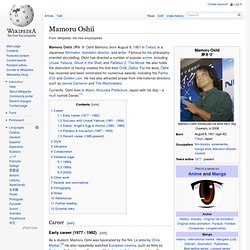
The following year, he entered Tatsunoko Productions and worked on his first anime as a storyboard artist on Ippatsu Kanta-kun.[6] During this period at Tatsunoko, Oshii worked on many anime as a storyboard artist, most of which were part of the Time Bokan television series. Success with Urusei Yatsura (1981 - 1984)[edit] Dallos, Angel's Egg & Anchor (1983 - 1985)[edit] Patlabor & live-action (1987 - 1993)[edit] Kenji Kawai. Ghost in the Shell (film) Ghost in the Shell follows the hunt of the public security agency Section 9 for a mysterious hacker known as the Puppet Master.
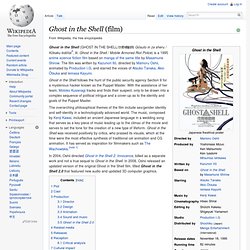
With the assistance of her team, Motoko Kusanagi tracks and finds their suspect, only to be drawn into a complex sequence of political intrigue and a cover-up as to the identity and goals of the Puppet Master. The overarching philosophical themes of the film include sex/gender identity and self-identity in a technologically advanced world. Saving Private Ryan. Rodat conceived the film's story in 1994 when he saw a monument dedicated to eight siblings killed in the American Civil War.
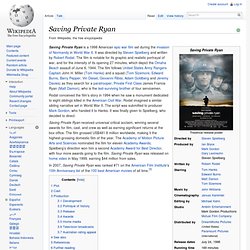
Rodat imagined a similar sibling narrative set in World War II. The script was submitted to producer Mark Gordon, who handed it to Hanks. It was finally given to Spielberg, who decided to direct. Saving Private Ryan. Saving Private Ryan opens and closes with an identical image -- an American flag, rippling in the wind.
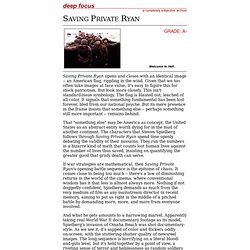
Given that we too often take images at face value, it's easy to figure this for stock patriotism. But look more closely. This isn't standard-issue symbology. The flag is blasted out, leached of all color. It signals that something fundamental has been lost forever, bled from our national psyche. That "something else" may be America as concept, the United States as an abstract entity worth dying for in the mud of another continent.
If war strategies are mathematical, then Saving Private Ryan's opening battle sequence is the epitome of chaos. And what he gets amounts to a harrowing marvel. How else to film a war? The difference between Ryan and Vietnam pictures like Jacket or Platoon is largely that, while the Vietnam War is generally acknowledged to have been a botched job, it's far harder to dismiss World War II as military folly. Steven Spielberg. The Big Sleep (1946 film) The Big Sleep is a 1946 film noir[2][3] directed by Howard Hawks, the first film version of Raymond Chandler's 1939 novel of the same name.
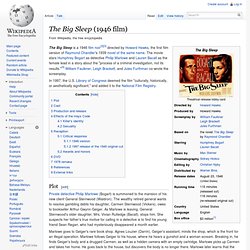
The movie stars Humphrey Bogart as detective Philip Marlowe and Lauren Bacall as the female lead in a story about the "process of a criminal investigation, not its results. Humphrey Bogart. Humphrey DeForest Bogart (December 25, 1899 – January 14, 1957)[1][2] was an American actor[3] and is widely regarded as an American cultural icon.[4][5] In 1999, the American Film Institute ranked Bogart as the greatest male star in the history of American cinema.

Early life[edit] Bogart was born on Christmas Day, 1899 in New York City, the eldest child of Dr. Belmont DeForest Bogart (July 1867, Watkins Glen, New York – September 8, 1934, Tudor City apartments, New York City) and Maud Humphrey (1868–1940). Belmont and Maud married in June 1898. The name “Bogart” comes from the Dutch surname “Bogaert”. Bogart's birthday has been a matter of dispute; according to Warner Bros, he was born on Christmas Day, 1899. Lauren Bacall. In 1999, Bacall was ranked #20 of the 25 actresses on the AFI's 100 Years... 100 Stars list by the American Film Institute.
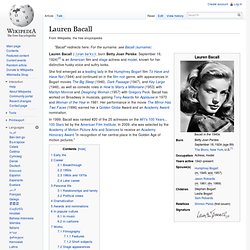
In 2009, she was selected by the Academy of Motion Picture Arts and Sciences to receive an Academy Honorary Award "in recognition of her central place in the Golden Age of motion pictures. " Early life[edit] Career[edit] Breakthrough[edit] On the set, Humphrey Bogart, who was married to Mayo Methot, initiated a relationship with Bacall several weeks into shooting and they began seeing each other.